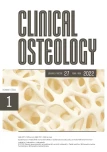Chondroblastoma of the femur a benign tumor with potentially serious consequences: a case report
Authors:
Rendek Pavol 1; Kokavec Milan 1; Chládek Petr 2
Authors place of work:
Ortopedická klinika LF UK a NÚDCH, Bratislava
1; Ortopedické oddělení, Vršovická zdravotní a. s., Praha
2
Published in the journal:
Clinical Osteology 2022; 27(1): 36-39
Category:
Kazuistiky
Summary
Chondroblastoma is a rare benign bone tumor, most often located in an epiphysis. It represents about 1 % of all benign bone tumors. Chondroblastoma is typical for young patients and occurs most often in the second decade of life. Clinical presentation consists of pain and restriction of movement in the affected joint. Histology shows a benign type of tumor, which can however grow aggressively and destroy its surroundings (spongiosa, cortical bone and joint cartilage) and expand into the joint cavity. Tumor cells produce cytokines, which are responsible for inflammatory processes occurring around the tumor such as bone edema or prominent synovitis in case of intraarticular growth. In 20 % of cases, we see a relapse despite treatment. In this article we present the case of a 15-year-old boy with a proximal femur chondroblastoma. After the initial biopsy, the tumor was treated surgically via surgical hip dislocation, which allows treatment of the femoral head without compromising nutritional blood vessels. After a radical excochleation and local chemoproteolysis, the defect was filled with partially resorbable bone cement. The patient has been monitored for a year now with a good clinical and radiological outcome.
Keywords:
chondroblastoma – proximal femur – surgical hip dislocation
Zdroje
1. Kurt AM, Unni KK, Sim FH et al. Chondroblastoma of bone. Hum P athol 1 989; 2 0(10): 9 65–976. Dostupné z DOI: < http://dx.doi. org/10.1016/0046–8177(89)90268–2>.
2. Xu H, Nugent D, Monforte HL et al. Chondroblastoma of bone in the extremities: a multicenter retrospective study. J Bone Joint Surg Am 2015; 9 7(11): 9 25–931. Dostupné z DOI: < http://dx.doi.org/10.2106/ JBJS.N.00992>.
3. Bloem JL, Mulder JD. Chondroblastoma: a clinical and radiological study of 104 cases. Skeletal Radiol 1985; 14(1): 1–9. Dostupné z DOI: <http://dx.doi.org/10.1007/BF00361187>.
4. de Silva MVC, Reid R. Chondroblastoma: varied histological appearance, potential diagnostic pitfalls, and clinicopathologic features associated with local recurrence. Ann Diagn Pathol 2003; 7(4): 205–213. Dostupné z DOI: <http://dx.doi.org/10.1016/s1092–9134(03)00048–0>.
5. Oxtoby JW, Davies AM. MRI characteristics of chondroblastoma. Clin Radiol 1996; 51(1): 2 2–26. Dostupné z DOI: <http://dx.doi.org/10.1016/s0009–9260(96)80213–3>.
6. Uchikawa C, Shinozaki T, Nakajima T et al. Cytokine Synthesis by Chondroblastoma: Relation to Local Inflammation. J Orthop Surg (Hong Kong) 2009; 17(1): 56–61. Dostupné z DOI: <http://dx.doi.org/10.1177/230949900901700113>.
7. Chen W, DiFrancesco LM. Chondroblastoma: An Update. Arch Pathol Lab Med 2017; 141(6): 867–871. Dostupné z DOI: <http://dx.doi.org/.5858/arpa.2016–0281-RS>.
8. Lin PP, Thenappan, Arun BS et al. Treatment and Prognosis of Chondroblastoma. C lin O rthop R elat R es 2 005; 4 38: 1 03–109. Dostupné z DOI: <http://dx.doi.org/10.1097/01.blo.0000179591.72844.c3>.
9. Turcotte RE, Kurt A-M, Sim FH et al. Chondroblastoma. Hum Pathol 1993; 24(9): 944–949. Dostupné z DOI: <http://dx.doi.org/10.1016/0046–8177(93)90107-r>.
Štítky
Biochemie Dětská gynekologie Dětská radiologie Dětská revmatologie Endokrinologie Gynekologie a porodnictví Interní lékařství Ortopedie Praktické lékařství pro dospělé Radiodiagnostika Rehabilitační a fyzikální medicína Revmatologie Traumatologie OsteologieČlánek vyšel v časopise
Clinical Osteology

2022 Číslo 1
Nejčtenější v tomto čísle
- Chondroblastóm femuru – benígny nádor s potenciálne vážnymi následkami: kazuistika
- Casus socialis: sociálny či medicínsky problém? Kazuistika
- Změny kostní denzity a riziko osteoporotických fraktur u pacientů s psoriatickou artritidou
- A need for predictive and personalized approach in osteoporosis treatment: individual treatment plan
